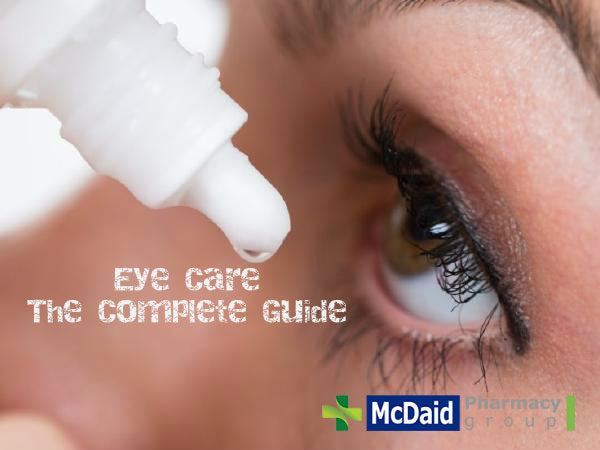Eye Care
There are around four main types of eye problems you might encounter,
Infection, allergic reactions, dry eyes and tired eyes.
Conjunctivitis
Infection in the eyes may be caused by bacteria or viruses. Infective conjunctivitis is an infection affecting the conjunctiva (the lining of the eyeball), this infection makes the whole white of the eye redden as well as the inside of the eyelids and the patient will experience a gritty sensation under the eye lids. Often the eye appears sticky on awakening. This infection is bacterial conjunctivitis. Viral conjunctivitis presents with a watery discharge and is often associated with symptoms of a cold and flu. Conjunctivitis frequently starts in one eye, but can spread into the other one. It is very contagious.
Styes
Are caused by an infection at the base of an eyelash hair follicle and will appear as a red swelling on the inside margin of the eye lid. The swelling can spread to the area around the stye and can be very painful; normally styes come to a head and burst or shrink and get better within a day or two.
Blepharitis
Affects the eyelids and causes redness and irritation and in many cases both eyelids will be affected. It can be caused by an infection but the majorty of cases it affects patients who suffer with flaky skin conditions such as dandruff or seborrhoeic dermatitis.
Allergic reactions
Of the eye also result in conjunctivitis, that is, inflammation of the lining of the eye resulting in itchy watery and red eyes. It is most common in people allergic to pollen but can be caused by some soaps and cosmetic products
Dry eye
Essentially, a reduction in tear volume or alteration in tear composition causes dry eyes. Underproduction of tears can be the result of increased evaporation from the eye, increased tear drainage and a decrease in tear production by the lacrimal gland.
Symptoms can include tired itchy irritated eyes often with a burning sensation. It is important not to let the eye lid dry out and this condition can be treated with artificial tear bout OTC.
Tired eyes are often a result from looking at computer screens for long periods of time leading to a discomfort and redness
Watery eyes can develop as part of an allergy or if someone has been exposed to a smoky atmosphere
Treatments For Bacterial Conjuntivitis
Propamidine isethionate 0.1% (Brolene and Golden Eye Drops)
Dibromopropamidine isethionate 0.15% (Golden Eye Ointment)
are only licensed for adults and children over the age of 12. (however are safe from 1-2years)
There is no lower age limit for use of either the drops or the ointment. However if the patient is under the age of 2 years and the infection is more than minor, advice should be given to visit the doctor
The dose for eye drops is one or two drops up to four times daily, whereas the ointment should be applied once or twice daily. If there has been no significant improvement after 2 days the person should be referred to their GP. Blurring of vision on instillation may occur but is transient. The manufacturers state that use in pregnancy has not been established but there appears to be no reports of teratogenic effects and therefore could be used in pregnancy if deemed appropriate. They are free from drug interactions and can be given to all patient groups.
Chloramphenicol
(e.g. Golden Eye Antibiotic Drops/Ointment, Optrex Infected Eye Drops/ Ointment, Brochlor Eye Ointment ) – OTC in uk
in ROI-(chloromycetin POM)
Chloramphenicol drops and ointment are licensed for use in children over the age of 2 years old. The recommended dosage for the drops is one drop every two hours for the first 48 hours then reducing to four times a day for a maximum of 5 days treatment. The ointment, if used in conjunction with the drops, should be only applied at night – approximately 1 cm of ointment should be applied to the inside of the eyelid, after which blinking several times will spread the ointment. If used alone, then the ointment should be used three or four times a day.
In pregnancy and breastfeeding there is a lack of manufacturer data for them to recommend their use. Practically, during pregnancy hygiene measures should be adopted and if absolutely necessary they can be used in breastfeeding women.
For infants and babies under 2 we recommend using:
TLC eye care Wipes , Blephasol Eye wipes, sterile water and cotton wool
Clean and bathe the eye, as it is a self limiting condition it should resolve within 2-5 days.
Treatments for allergic conjunctivitis and hayfever
Mast cell stabilisers
(sodium cromoglicate) Intraocular sodium cromoglicate (e.g. Opticrom Allergy, Optrex Allergy) is a prophylactic agent and therefore has to be given continuously whilst exposed to the allergen. One or two drops should be administered in each eye four times a day. Although no minimum age is stated for their use, data on file from Sanofi Aventis (Opticrom Allergy) show it can be used from children over the age of six. Clinical experience has shown it to be safe in pregnancy
and expert opinion considers sodium cromoglicate to be safe in breastfeeding. It has no drug interactions and can be given to all patient groups. Instillation of the drops may cause a transient blurring of vision.
Sympathomimetics
These agents can be used to reduce redness of the eye. Products either contain a combination of sympathomimetic and antihistamine (antazoline/xylometazoline, Otrivine Antistin)
or sympathomimetic alone (e.g. Naphazoline 0.01%). They are useful in reducing redness in the eye but will not treat the underlying pathology that is causing the eye to be red. They should be limited to short-term use to avoid rebound effects. Like all sympathomimetics they can interact with monoamine oxidase inhibitors and should not be used by patients receiving such treatment or within 14 days of ceasing therapy.
(Sympathomimetic drugs are stimulant compounds which mimic the effects of endogenous agonists of the sympathetic nervous system)
Otrivine Anthistin
Used in adults and children over 12 years, the dose is 1 or 2 drops two or three times a day. Patients with glaucoma should avoid this product due to the potential of the antihistamine component to increase intraocular pressure. Local transient irritation and a bitter taste after application have been reported.
Naphazoline (e.g. Murine, Optrex Bloodshot Eyes Eye Drops & Optrex Eye Brightening Drops)
The use of products containing naphazoline is restricted to adults and children over the age of 12 years old. One to two drops should be administered into the eye three or four times a day.
Styes
Although styes are caused by bacterial pathogens the use of antibiotic therapy is not usually needed. Topical application of ocular antibiotics does not result in speedier symptom resolution but it might prevent a subsequent staphylococcal infection from a lash lower down. A warm compress, applied for 5–10 minutes, every three or four times a day might bring to a head an external stye and once burst, the pain will subside and the symptoms resolve. The use of dibromopropamidine has been advocated in the treatment of styes but is of unproven benefit, if unsure it is safe to recommend Brolene or Golden eye in addition to warm compress.
Dry eye
The dosage of all products marketed for dry eye is largely dependent on the patient’s need for lubrication, and is therefore given on a when-required basis. None of these products is known to interact with any medicine, they cause minimal and transient side effects and are suitable for all patient groups.
Hypromellose and carmellose
Hypromellose is widely available as a non-proprietary medicine in a strength of 0.3%; it is also available at 0.5% (Isopto Plain) and 1% (Isopto Alkaline); carmellose is available as 0.5%. Both might require hourly or even halfhourly dosing initially, which should reduce as symptoms improve. They are pharmacologically inert and all patientgroups should be able to use it safely, including pregnant and breastfeeding women. However, because of a lack of data, some manufacturers err on the side of caution and recommend that it should be avoided.
Polyvinyl alcohol Two proprietary products are available; Liquifilm Tears and Sno Tears. The standard dose is four times day. Liquifilm is also available as a preservative-free formulation. It can be given to all patient groups.
Carbomer (E.g. Clinitas Gel, GelTears, Liposic, Liquivisc, Viscotears) Manufacturers recommend that adults and the elderly use one drop three or four times a day or as required, depending upon patient need. Due to the products viscosity, carbomer should be used last if other eye drops need to be instilled. Manufacturers advise avoidance in pregnancy and lactation due to insufficient data. Clinical experience, however, has shown carbomer can be used safely in these patient groups.
Lubricants Wool fats (e.g. Lacri-Lube and Simple eye ointment) These products contain a mixture of white soft paraffin, liquid paraffin and wool fat. They are useful at bedtime when prolonged lubrication is needed but because they blur vision are unsuitable during the day. They are pharmacologically inert and can be used in pregnancy and breastfeeding.
Sodium hyaluronate
(e.g. Hayabak, Oxyal , hylo-forte) The dose for all products containing sodium hyaluronate is on a when-needed basis. Some examples below:
HYLO®-Care is recommended for patients with severe dry eye or where there is an injury to the outside layer of the cornea.
HYLO®-FORTE- A preservative-free eye drop containing 0.2% Sodium Hyaluronate which provides a longer lasting, intensive, soothing relief for more severe cases of dry eye.
HYLO®-DUAL- Recommended for Allergy Related Dry Eye, HYLO®-DUAL is preservative-free
HYLO®-TEAR – A Preservative free eye drop containing 0.1% Sodium Hyaluronate which provides long lasting, soothing relief for more moderate forms of dry eye.
VitA-POS® is a sterile, preservative-free eye ointment containing light liquid paraffin and Vitamin A. Suitable for moderate to severe dry eye and mostly recommended for night time use.
Top Tip!
Preservatives in eye drops – Many eye drops contain benzalkonium chloride which itself can cause eye irritation. If symptoms persists or are worsened by the eye drops it may be worth trying a preservative-free formulation or single dose unit preparations
Hints and tips!
Children and school – The Health Protection Agency recommends (2010) that children with conjunctivitis do not need to be kept away from schools
Contact Lens wearers- Patients who wear soft contact lenses should be advised to stop wearing them while treatment continues and for 48 hours afterwards. This is because preservatives in the eye drops can damage the lenses
Brolene and Golden Eye drops- If the patient is instructed to use the drops every 2 hours rather than four times a day then the drops will probably be more efficacious. However this is outside the current product license
Choramphenicol drops – These must be stored in the fridge. If they are put into the eye cold it will be uncomfortable so patients should be told to remove them from the fridge prior to use to allow them to warm up to room temperature
How do I put Them in?
Administration of eye drops
1. Wash your hands
2. Tilt your head backwards, until you can see the ceiling
3. Pull down the lower eyelid by pinching outwards to form a small pocket, and look upwards
- Holding the dropper in the other hand, hold it as near as possible to the eyelid without touching it
5. Place one drop inside the lower eyelid then close your eye
6. Wipe away any excess drops from the eyelid and lashes with the clean tissue
7. Repeat steps 2 to 6 if more than one drop needs to be administered
Administration of eye ointment
1. Repeat eye drop steps 1 and 2
2. Pull down the lower eyelid
3. Place a thin line of ointment along the inside of the lower eyelid
4. Close your eye, and move the eyeball from side to side
5. Wipe away any excess ointment from the eyelids and lashes using the clean tissue
6. After using ointment, your vision may be blurred, but will soon be cleared by blinking



